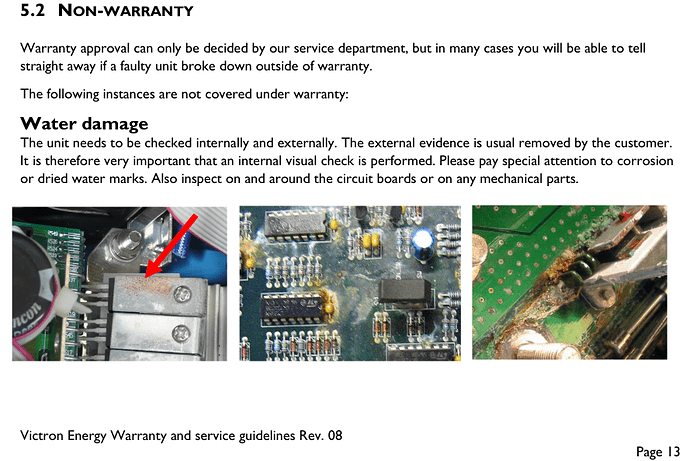Yeah but if he uses wrap then he can peel send in for repair and then wrap black again if he has henry ford personality.
Yeah, like those wraps they put on cars and even gaming consoles. I would like a themed inverter. It would look so good in my garage. ![]()
In all seriousness, I thought West Coast Inverters were a new brand of inverter locally made, and our OP was looking to get our recommendation on buying it… so I almost didn’t open up the thread. ![]() But boy am I glad I did!
But boy am I glad I did!
thank you @_a_a_a .
I thought this was “West Coast Investors”. ![]()
I’m intrigued by this statement, especially the micro-grid part. Is it their specialty?
(I ask as I have a friend running a large farm with many people, workers buildings, houses spread out, etc)
I looked at the SMA rig when I first started looking at Solar, $$$ for sure, but also now with the Tripower Hybrid inverter with IP65 rating the whole set-up may not be much more expensive than Victron, and easier to self-install…I think, could be wrong, bit of a thumbsuck comment…emphasized text
![]() I read “…a lemon…”
I read “…a lemon…”
Poor lemons.
I’m talking more of a traditional SMA microgrid setup. I wasn’t even aware of the Tripower hybrid. Thanks for that!
In such a system all the PV is AC-coupled, so the entire system consists of one or more PV-inverters (typically Sunny Boy) that generate AC directly into the grid. For an off-grid setup, you then add a Sunny Island battery inverter (which creates the “grid” that everything else ties with). This means the base cost (when you have only one Sunny Island and one Sunny Boy) is quite high. But if you are building a small microgrid, as you scale it up, it becomes quite a powerful system.
Because it is AC-coupled, ie we’re working with higher voltages, it allows things to be a little more distributed.
Of course I have to point out that you can do the same thing with a Victron inverter, and for less money. You install one or more Multis or Quattros for the battery side, or you can even use a Phoenix inverter (which is a Multi without an AC input), and then hang a bunch of Fronius PV-inverters on the output. Exactly the same topology, and it allows you to make the same Microgrid.
The only thing I would advise about AC-coupled microgrids: Install a small amount of PV on a traditional MPPT charger. If the battery runs completely empty, you need something to black-start the system. Either that, or you need to have a backup generator.
Edit: Something else to keep in mind, there are rules as to how big the battery inverter must be to cope with the PV hung on the output side. For Victron this is 1:1. If you have 10kW of PV connected to the output, it must be a 10kW Multi/Quattro. I think for SMA it might be 2:1, which perhaps gives a little bit more space to work with, but for a stable system I’d still say 1:1 is better anyway.
Brochure-Sunny Tripower-5:6:8:10.pdf (587.1 KB)
The TriPower looks like it uses the same sort of topology as the Goodwe, the Sunsynk, or the Victron Multi RS. Also, Fronius has a hybrid too. Quite rare in this country, but they exist. Red at the bottom instead of black. Look, I love what I do and I love the blue inverters, but credit where it is due: This is a really nice inverter.
The Fronius Hybrid can actually operate like a normal PV-inverter without batteries too, for people who want to do it in stages.
The Sunny Boy Storage is also not too badly priced. But it is not a LF like the Sunny Island - which means lower surge capacity, which is less ideal for off-grid (IMHO).
?
…Low Frequency?..
Yes
The In-laws have a Dairy farm near Swellendam. They had to jump thru loops to get Solar installed on the farm. They have 3x 20KW Sunnys running on a 80KW pump… Not allowed to draw the full capacity from the sunnies, according to Eskom.
But also, they have 3 power points(not sure what to correct enligh is. Krag Punte), each with its own eskom supply. (they pay per point) So the only time this will work on a farm is if all the power comes from one point. Else they have to set one up one at each point. and that can push up the price…
I read this about the Sunny Island:
Off-Grid inverters of the Sunny Island family enable a bi-directional DC/AC conversion and are therefore also designated as a combination of inverter and charging device or as an Inverter/Charger combi-device. Thus a rectifier as found in a grid-connected BTS is not necessary. Loads and generators can be integrated on both the AC and the DC side
Can someone explain how this is done??
The SunnyIsland is an LF-design bi-directional inverter very similar to the Victron Multiplus. So this explanation by Johannes Boonstra explains it.
Most of us are familiar with the simple passive rectifier in power supplies, which conducts the moment they are sufficiently forward-biased. This is actually terrible for power factor… I will get to that later as an aside.
But you can also do rectification actively, by using actual switches (MOSFETs or IGBTs) and just switching them perfectly in time with the AC waveform. Then you have an active rectifier. And once you have that, you can play with the timing and make the voltage lead or lag a bit, and then you can push the energy in either direction. Which is what both these inverters do.
Why did I say the power factor of a passive rectifier is terrible? Well, because a silicon diode typically has an 0.6V to 0.7V drop across it, and in a FULL BRIDGE RECTIFIER you got two of those so let’s say 1.5V total dead-space before they are pushed into conduction. Then you slap on a 1:20 transformer (let’s say you wanted to make 12V… ish), so now the first 30V of the AC waveform does nothing, which makes the current waveform totally non-linear. Bad power factor…
For (further?) interest sake, you may also find the implementation of a precision rectifier interesting. You can’t really use it for any sort of high power levels, and it needs power to run, but when measuring small signals, it is invaluable. It gets rid of that 0.6V drop… ![]()
Indeed. Check this video by Great Scott on this subject: https://www.youtube.com/watch?v=U5cqrrhq9TA&ab_channel=GreatScott!
Fixing this problem isn’t a quick fix however!
What… nobody clicked the
link!?
That was the best one!
![]()
And here’s the low-down on IGBTs: Electric grids fed by renewables need a different kind of plumbing
https://archive.is/LhXVv

